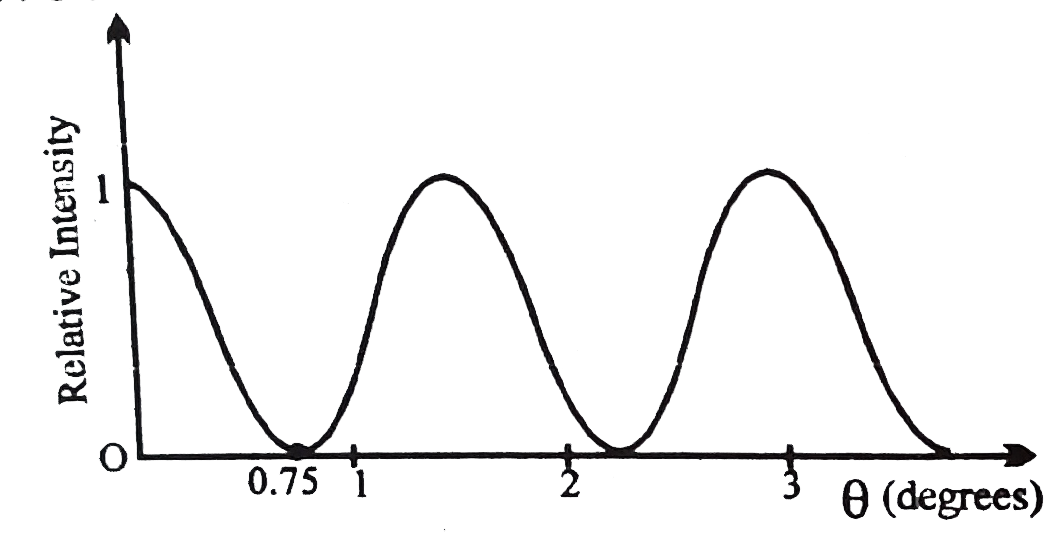Laser light of wavelength 630 nm incident on a pair of slits produces an interference pattern in which the fringes are seprated by 8.1mm .A second laser light produces an interference pattern in which the fringes are seprated by 3.6 mm.Calculate the wavelength of the second light
The correct Answer is:80 N, 48 N, 264 N
To solve the problem, we need to use the relationship between the fringe separation (β) and the wavelength (λ) of the light in an interference pattern. The formula that relates these quantities is given by:
β=λDd
Where:
- β = fringe separation
- λ = wavelength of the light
- D = distance from the slits to the screen
- d = distance between the slits
Since D and d are constant for both light sources, we can conclude that the fringe separation is directly proportional to the wavelength of the light. Therefore, we can write:
β2β1=λ2λ1
1. Identify the given values:
- Wavelength of the first light (λ1) = 630 nm
- Fringe separation for the first light (β1) = 8.1 mm
- Fringe separation for the second light (β2) = 3.6 mm
- Wavelength of the second light (λ2) = ?
2. Set up the proportion:
Using the relationship derived above:
β2β1=λ2λ1
3. Substitute the known values into the equation:
3.6 mm8.1 mm=λ2630 nm
4. Cross-multiply to solve for λ2:
λ2=3.6 mm8.1 mm×630 nm
5. Calculate the fraction:
3.68.1=0.4444(approximately)
6. Now calculate λ2:
λ2=0.4444×630 nm≈280 nm
Final Answer:
The wavelength of the second light (λ2) is approximately 280 nm.
- β = fringe separation
- λ = wavelength of the light
- D = distance from the slits to the screen
- d = distance between the slits
- Wavelength of the first light (λ1) = 630 nm
- Fringe separation for the first light (β1) = 8.1 mm
- Fringe separation for the second light (β2) = 3.6 mm
- Wavelength of the second light (λ2) = ?
Using the relationship derived above:
β2β1=λ2λ1
3.6 mm8.1 mm=λ2630 nm
λ2=3.6 mm8.1 mm×630 nm
3.68.1=0.4444(approximately)
λ2=0.4444×630 nm≈280 nm
The wavelength of the second light (λ2) is approximately 280 nm.
Topper's Solved these Questions
- NEWTON'S LAWS OF MOTION & FRICTIONBOOK - ALLENCHAPTER - NEWTON'S LAWS OF MOTION & FRICTIONEXERCISE - EXERCISE (S-2)
9 Videos
- NEWTON'S LAWS OF MOTION & FRICTIONBOOK - ALLENCHAPTER - NEWTON'S LAWS OF MOTION & FRICTIONEXERCISE - EXERCISE (O-1)
51 Videos
- NEWTON'S LAWS OF MOTION & FRICTIONBOOK - ALLENCHAPTER - NEWTON'S LAWS OF MOTION & FRICTIONEXERCISE - EXERCISE (JA)
4 Videos
- MOTION IN A PALNEBOOK - ALLENCHAPTER - MOTION IN A PALNEEXERCISE - SOLVED EXAMPLE
28 Videos
- NEWTONS LAWS OF MOTIONBOOK - ALLENCHAPTER - NEWTONS LAWS OF MOTIONEXERCISE - EXERCISE-III
28 Videos
Similar Questions
Laser light of wavelength 630 nm incident on a pair of slits produces an interference pattern in which the fringes are seprated by 8.1mm .A second laser light produces an interference pattern in which the fringes are seprated by 7.2 mm .calculate the wavelength of the second light .
View SolutionLaser light of wavelength 1260 nm incident on a pair of slits produces an interference pattern in which the fringes are seprated by 8.1mm .A second laser light produces an interference pattern in which the fringes are seprated by 7.2 mm.Calculate the wavelength of the second light
View SolutionLaser light of wavelength 315 nm incident on a pair of slits produces an interference pattern in which the fringes are seprated by 8.1mm .A second laser light produces an interference pattern in which the fringes are seprated by 7.2 mm.Calculate the wavelength of the second light
View SolutionLaser light of wave length 600 nm incident on a pair of slits produces an interference pattern in which the bright fringes are separated by 8mm. A second light produces an interference pattern in which the fringes are separated by 12 mm. Calculate the wavelength of the second light.
View SolutionLaser light of wavelength 630nm incident on a pair of slits produces an interference pattern where bright fringes are separated by 8.1mm. Another light produces the interference pattern, where the bright fringes are separated by 7.2mm. Calculate the wavelength of second light.
View SolutionIn Young's double slit experiment ,momochromatic light of wavelength 630nm illuminates the pair of slits and produces an interface pattern pattern in which two consecutive bright frings are separated by 8.1mm. Another source of monochromatic light produce the interface pattern in which the two consecutive bright fringes are seperated by 7.2mm, find the wavelength of light from the second sources . What is the effect to on the interference fringes if the monochromatic sources is replaced by a source of white light ?
View SolutionLaser light of wavelength 630 nm is incident on a pair of slits which are separated by 1.8 mm. If the screen is kept 80 cm away from the two slits, calculate :
fringe separation i.e., fringe width
View SolutionLaser light of wavelength 630 nm is incident on a pair of slits which are separated by 1.8 mm. If the screen is kept 80 cm away from the two slits, calculate :
distance of 10th bright fringe from the centre of the interference pattern.
View SolutionLight of wavelength 520nm passing through a double slit,produced interference pattern of relative intensity versus deflection angle θ as shown in the figure.find the separation of between the slits.

View SolutionLight of wavelength 600 nm is incident normally on a slit of width 0.2 mm. The angular width of central maxima in the diffraction pattern is
View Solution
